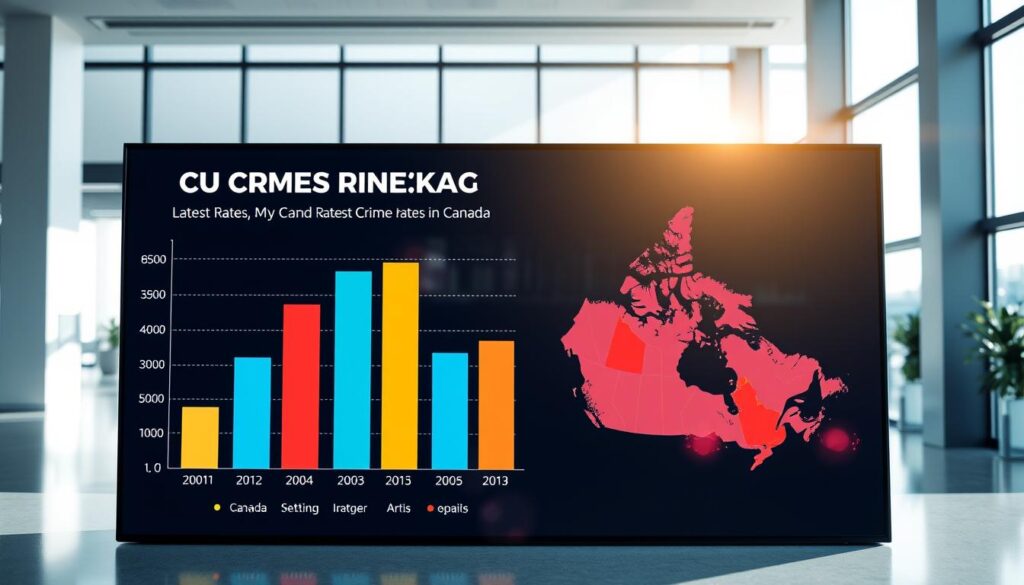Canada’s crime landscape is undergoing a significant shift. According to Statistics Canada, the Crime Severity Index (CSI) rose by 2% in 2023, marking the third consecutive year of increase. This upward trend, which began in 2015, is largely driven by a surge in reported fraud, extortion, and child pornography cases, which soared by 52%.
The police-reported crime rate per 100,000 people stood at 5,843 in 2023, reflecting a 2.5% annual change. Understanding these trends is crucial for public safety, policy development, and community awareness. As data continues to shape our understanding of crime patterns, it’s essential to stay informed about the current state of crime in Canada.
Current Crime Trends in Canada
Understanding current crime trends in Canada requires a nuanced approach, considering both the volume and severity of crimes. The country’s crime landscape is influenced by various factors, including socioeconomic conditions and law enforcement strategies.
Recent Statistical Overview
According to recent statistics, Canada has seen fluctuations in its crime rates. For the most up-to-date information on violent crime rates, visit Canada’s Violent Crime Rate. The data indicates that certain types of crimes are becoming more prevalent in specific areas, affecting the overall crime severity index.
| Crime Type | Rate per 100,000 Population | Severity Index Score |
|---|---|---|
| Violent Crime | 750 | 120 |
| Property Crime | 3,500 | 80 |
| Total Crime Rate | 4,250 | 100 |
Crime Severity Index Explained
The Crime Severity Index (CSI) is a sophisticated measure that reflects the relative seriousness of individual offenses and tracks changes in crime severity. It includes all Criminal Code violations, drug violations, and Federal Statutes, with each offense assigned a weight based on its seriousness as determined by actual sentencing practices across Canadian courts.

The CSI is considered a more accurate reflection of crime trends than simple crime counts because it accounts for both the volume and severity of crimes. The index is divided into the overall CSI, Violent CSI, and Non-violent CSI, providing a nuanced view of crime in Canada. Policymakers and law enforcement agencies use the CSI to inform their understanding of crime patterns and develop appropriate responses.
Understanding Crime Rate Canada
To comprehend the current state of crime in Canada, it’s essential to examine the methodologies used to measure crime rates. Understanding how crime is measured provides insight into the trends and patterns observed in Canadian crime statistics.
How Crime Rates Are Measured
Crime rates in Canada are measured using various indices, with the Violent Crime Severity Index being a key metric. This index takes into account the severity of violent crimes reported by police services across the country. In 2023, the Violent Crime Severity Index remained virtually unchanged at 99.5, indicating a stable trend in violent crime severity. The measurement of crime rates involves aggregating data on different types of crimes, including homicide, assault, robbery, and sexual assault, among others.
The police-reported data is crucial for understanding crime trends. For instance, the homicide rate decreased by 14% in 2023 compared to the previous year, contributing to the overall stability of the Violent Crime Severity Index. This decrease is a significant factor in understanding the current state of violent crime in Canada.

Violent vs. Non-Violent Crime Statistics
Analyzing the differences between violent and non-violent crime statistics provides a comprehensive view of Canada’s crime landscape. Violent crimes include homicide, robbery, and sexual assault, while non-violent crimes encompass property crimes like breaking and entering, theft, and fraud. In 2023, there was a notable decrease in breaking and entering, with a 5% drop, continuing a trend observed since the 1990s.
Conversely, hate crimes saw a significant increase, with 4,777 reported incidents, representing a 32% rise from 2022. Most of these hate crimes targeted religion or sexual orientation. Understanding these trends is crucial for developing effective crime prevention strategies.
The distinction between violent and non-violent crime rates is influenced by various factors, including socioeconomic conditions, law enforcement priorities, and legislative changes. By examining these factors, we can better understand the relative prevalence of different crime types and how Canada’s crime landscape has evolved.
Regional Crime Rate Variations Across Canada
Canada’s vast geography encompasses diverse regions, each with its unique crime rate characteristics. This diversity necessitates a closer examination of crime trends at the provincial level and between urban and rural areas.
Provincial Crime Rate Comparison
Crime rates vary significantly across Canada’s provinces. Provincial crime rate comparisons reveal that some regions experience higher rates of certain crimes. For instance, property crime rates, including motor vehicle theft, tend to be higher in certain provinces. In 2023, there was a notable increase in motor vehicle theft across many provinces, with a overall rise of 5% from the previous year.
The crime rate in each province is influenced by factors such as population density, economic conditions, and policing strategies. Understanding these variations is crucial for developing targeted crime prevention initiatives.
Urban vs. Rural Crime Patterns
The distinction between urban and rural crime patterns is another critical aspect of Canada’s crime landscape. Generally, rural areas report higher rates of property crimes, such as theft of motor vehicles and equipment. In contrast, urban centers tend to experience higher rates of violent crimes, including robberies, which saw a 4% increase in 2023.

The differences in crime patterns between urban and rural areas can be attributed to various factors, including population density, police response times, and socioeconomic conditions. Effective crime prevention strategies must consider these differences to address the unique challenges faced by urban and rural communities.
Most Common Types of Crime in Canada
Understanding the most common types of crime in Canada is crucial for developing effective crime prevention strategies. Canada’s crime landscape is characterized by various types of offenses, including property crimes, violent crimes, and emerging trends.
Property Crimes
Property crimes are a significant concern in Canada, with theft being one of the most common offenses. These crimes can range from shoplifting to motor vehicle theft, causing financial losses for individuals and businesses. Effective law enforcement and community engagement are key to reducing property crime rates.

Violent Crimes
Violent crimes, including homicide, assault, and robbery, are a serious issue in Canada. These crimes have a profound impact on victims and their families, as well as on community safety. Understanding the causes and trends of violent crime is essential for developing targeted interventions.
Emerging Crime Trends
Emerging crime trends in Canada include a significant increase in hate crimes, with 4,777 incidents reported in 2023, representing a 32% rise from 2022. Fraud and extortion are also on the rise, with a 12% and 35% increase, respectively. Additionally, child pornography cases surged by 52% in 2023, partly due to enhanced awareness and better collaboration among law enforcement agencies. Cybercrime, including ransomware attacks and identity theft, continues to evolve in sophistication and scale.
Canada’s Criminal Code and Justice System
Canada’s justice system is built upon a comprehensive criminal code that outlines the country’s laws and regulations. This foundational document is crucial for understanding how crime is addressed and managed across the nation.
Key Elements of the Criminal Code
The Criminal Code of Canada is a detailed legal document that categorizes various offenses and prescribes corresponding penalties. It includes provisions for violent and non-violent crimes, ensuring that the justice system can effectively prosecute a wide range of criminal activities. As stated by the Canadian government, “The Criminal Code is the primary source of criminal law in Canada,” highlighting its importance in the country’s legal framework.
The code is regularly updated to reflect changing societal values and emerging crime trends, such as cybercrime and organized crime. This ensures that law enforcement agencies have the necessary legal tools to combat new forms of criminal activity.
Law Enforcement Structure in Canada
Canada’s law enforcement structure is multi-layered, comprising municipal, provincial, and federal police services. The Royal Canadian Mounted Police (RCMP) serves as the national police force, with jurisdiction in rural areas and the northern territories. As of 2005, there were 61,050 police officers in Canada, or one police officer per 528.6 persons, with significant regional variations.
Provincial police forces, such as the Ontario Provincial Police and the Sûreté du Québec, operate in their respective provinces. The division of policing responsibilities among different levels of government ensures a coordinated approach to law enforcement, with municipalities, provinces, and the federal government playing distinct roles in funding and directing police services.

Comparing Canadian Crime Rates Internationally
Canada’s crime rates can be better understood by examining how they compare to other countries around the world. This comparison provides valuable context for assessing the country’s safety and security.
Canada vs. United States Crime Comparison
When comparing Canada’s crime rates to those of the United States, several differences emerge. Canada’s homicide rate is significantly lower, with 1.6 homicides per 100,000 people, compared to 4.5 per 100,000 in the United States. This translates to a homicide rate that is 2.7 times lower in Canada. Additionally, Canada’s robbery rate is 79.4 per 100,000, whereas the US rate is 102.2 per 100,000. These statistics highlight that Canada has a lower crime rate compared to its southern neighbor.

Global Crime Rate Rankings
Globally, Canada is ranked as the 11th safest country out of 163 nations according to the Institute for Economics & Peace Global Peace Index. However, when it comes to homicide rates, Canada ranks 95th, indicating a higher rate compared to some developed countries like Australia and England. The country’s homicide rate is tied with Chile for the lowest in the Americas.
- Canada’s crime statistics show 1.6 homicides, 79.4 robberies, and 62.9 sexual assaults per 100,000 population.
- In comparison, the United States reports 4.5 homicides, 102.2 robberies, and 110 sexual assaults per 100,000 population.
- Australia, on the other hand, has 1.3 homicides, 63.3 robberies, and 80.1 sexual assaults per 100,000 population.
These comparisons highlight the complexities of international crime rate comparisons, influenced by factors such as legal definitions, reporting practices, and data collection methods. Nonetheless, Canada’s relatively strong global safety ranking can be attributed to its social policies, gun control measures, and approach to criminal justice.
Crime Prevention Strategies in Canada
Crime prevention is a multifaceted approach in Canada, involving government initiatives, community programs, and individual actions. Effective crime prevention requires a comprehensive strategy that addresses the root causes of crime and promotes a safe environment for all Canadians.
Government Initiatives
The Canadian government implements various initiatives to prevent crime, including policies aimed at reducing youth crime and supporting victims of crime. These initiatives often involve collaboration with law enforcement agencies and community organizations to provide programs and services that address the needs of at-risk populations. For instance, programs focusing on youth crime prevention are crucial in diverting young people from criminal activities.
Community-Based Prevention Programs
Community-based prevention programs play a vital role in preventing crime by engaging local residents and organizations in crime prevention efforts. These programs may include neighborhood watch initiatives, after-school programs for youth, and community policing efforts. By fostering a sense of community and promoting cooperation between law enforcement and the public, these programs help to prevent crime and improve overall safety.
Individual Safety Measures
Individuals can take several steps to protect themselves and their property from crime. Canadian law enforcement recommends securing homes and vehicles, being aware of surroundings, and avoiding displaying valuable items. Digital safety is also crucial, with recommendations to use strong passwords, enable two-factor authentication, and be cautious about sharing personal information online. For parents, monitoring children’s online activities and teaching them about internet safety is a key prevention strategy. By taking these measures, Canadians can reduce their risk of becoming victims of crime and contribute to safer communities.

Conclusion: The Future of Crime Rates in Canada
The Crime Severity Index in Canada has been on the rise since 2015, indicating a need for sustained attention to crime prevention. This upward trend, including a 2% increase in 2023, marks the third consecutive year of rise, signaling a concerning pattern that warrants comprehensive analysis.
Emerging challenges in Canada’s crime landscape include significant increases in fraud (12%), extortion (35%), child pornography (52%), and hate crimes (32%). These trends underscore the evolving nature of criminal activities and the need for adaptive crime prevention strategies. Regional disparities in crime rates persist, with territories and western provinces like Manitoba and Saskatchewan experiencing substantially higher crime rates compared to eastern provinces.
Technological advances are creating new opportunities for crime, but they also provide law enforcement with innovative tools for detection and prevention. As Canada moves forward, it’s crucial to leverage these advancements while addressing the complex interplay of demographic shifts, economic factors, and social changes that influence crime patterns.
To effectively combat crime, Canada must adopt evidence-based, collaborative approaches that engage all levels of government, community organizations, and individual citizens. By working together and leveraging insights from Statistics Canada and criminological research, Canada can create safer communities across the country.
In conclusion, while Canada remains one of the world’s safest countries, addressing the evolving crime challenges requires continued research, data collection, and policy innovation. By understanding the current crime trends and statistics, and by working collaboratively, Canada can navigate the complexities of its crime rate and build a safer future for its population.

